Leila Mesdaghi
Genre: Performance, Video, Painting, Sculpture and Mixed Media Art
Website:
Her Art:
Mesdaghi seeks to connect with viewers in a visceral, evocative, emotional manner. To her, 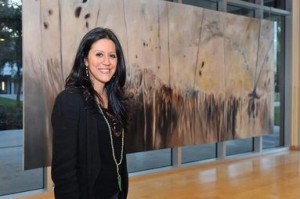 making art is a combination of emotional experience and social responsibility. Through her performance pieces, she comments on social and political issues like war in the Middle East, the negative reflections of Social Media in society, the housing crisis in the U.S, or the price and promise of progress.
making art is a combination of emotional experience and social responsibility. Through her performance pieces, she comments on social and political issues like war in the Middle East, the negative reflections of Social Media in society, the housing crisis in the U.S, or the price and promise of progress.
![droppedImage_2[1]](http://www.artswfl.com/wp-content/uploads/2016/05/droppedImage_211-300x225.jpg) For example, in Deeper Than Sorrow (third photo), Leila enters an pool in her father’s garden in Tehran, Iran that has been sitting empty for the past forty years. After absorbing her surroundings, she starts writing on the cracked and faded walls of the pool. Her marks behave as an instrument to recuperate from the pain of separation, opening a dialog between memory and perception, alluding to a universal longing. The marks she leaves
For example, in Deeper Than Sorrow (third photo), Leila enters an pool in her father’s garden in Tehran, Iran that has been sitting empty for the past forty years. After absorbing her surroundings, she starts writing on the cracked and faded walls of the pool. Her marks behave as an instrument to recuperate from the pain of separation, opening a dialog between memory and perception, alluding to a universal longing. The marks she leaves 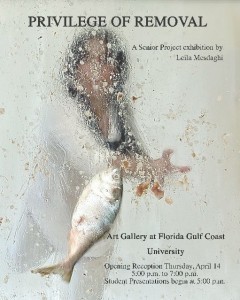 behind will fade as time goes by, but the memory of her presence will always remain. By merging performance and video, she explores the space between presence and absence.
behind will fade as time goes by, but the memory of her presence will always remain. By merging performance and video, she explores the space between presence and absence.
In her video performance piece titled Privilege of Removal, Mesdaghi throws dead fish at a pane of glass. In this way, she challenges the ways in which we observe, react and respond to social and political issues. “Privilege of Removal is about our relationships and how we relate to the ‘others’ in the universal sphere; the ones we are not related to, the ones we cannot relate to, and the ones we do not give a damn about,” Mesdaghi explains. “We watch real life behaviors of physical, verbal, and 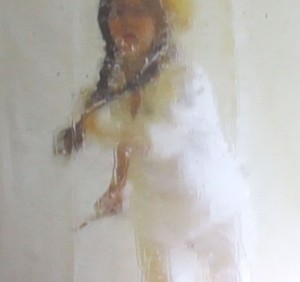 moral abuse on T.V and computer screens, and instead of rejecting, we justify and accept them as socio-political norms. By literally throwing dead fish at a pane of glass, I act as a violent exhibitionist and also remind the viewer of our silent voyeuristic nature. I smash dead fish against the barrier that separates the world we live in from the world we witness.”
moral abuse on T.V and computer screens, and instead of rejecting, we justify and accept them as socio-political norms. By literally throwing dead fish at a pane of glass, I act as a violent exhibitionist and also remind the viewer of our silent voyeuristic nature. I smash dead fish against the barrier that separates the world we live in from the world we witness.”
For this performance piece, Leila chose a remote, private location that was once used as a residential 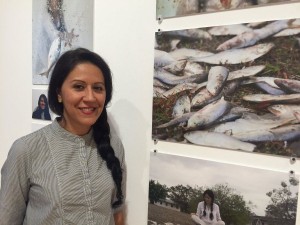 facility for people with development disabilities. The fact that it had warehoused people rejected by their immediate families serves as a metaphor for where moral and social responsibilities meet. “Just because we have the privilege to look from distance and the privilege to remove ourselves, problems do not end and people do not stop suffering,” Leila points out. “Just because we send decorated cans of food to Africa
facility for people with development disabilities. The fact that it had warehoused people rejected by their immediate families serves as a metaphor for where moral and social responsibilities meet. “Just because we have the privilege to look from distance and the privilege to remove ourselves, problems do not end and people do not stop suffering,” Leila points out. “Just because we send decorated cans of food to Africa 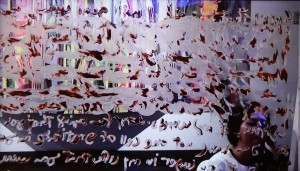 and Haiti does not mean that we have compassion and are ending hunger, homelessness, and wars.”
and Haiti does not mean that we have compassion and are ending hunger, homelessness, and wars.”
I’m Sorry for What I Said is another powerfully evocative video performance piece. It depicts Mesdaghi licking words written in chocolate off a piece of glass, leaving a residue of smears and 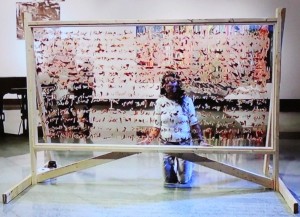 smudges with her lips and tongue “There were words that came out of my mouth that I wanted to take back,” Leila explains. “I ate what I said, licked my words away and tried to heal the wounds. The residue is the memory of the pain, and that, I cannot take back.”
smudges with her lips and tongue “There were words that came out of my mouth that I wanted to take back,” Leila explains. “I ate what I said, licked my words away and tried to heal the wounds. The residue is the memory of the pain, and that, I cannot take back.”
Leila was one of three Wish Ambassadors that Florida SouthWestern State College (then, Edison 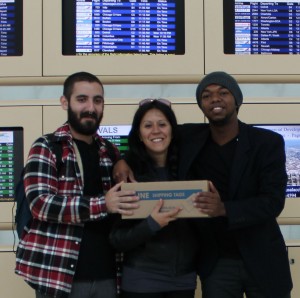 State College) sent to Reykjavik, Iceland in March of 2014 for purposes of delivering a box of wishes for world and personal peace that were collected by the Bob Rauschenberg Gallery during the Yoko Ono Imagine Peace exhibition that opened there on January 24. (Her companions on this trip were Josue’ Charles and Christopher Lacoste, with studio art instructor Dana Roes functioning as chaperone.)
State College) sent to Reykjavik, Iceland in March of 2014 for purposes of delivering a box of wishes for world and personal peace that were collected by the Bob Rauschenberg Gallery during the Yoko Ono Imagine Peace exhibition that opened there on January 24. (Her companions on this trip were Josue’ Charles and Christopher Lacoste, with studio art instructor Dana Roes functioning as chaperone.)
Leila had intended from the outset to lens a performance art piece during her stay in Iceland. 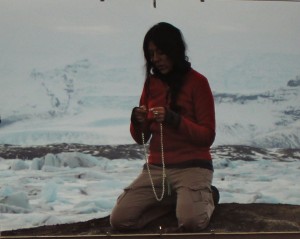 She even brought along a chair that she’d used in a performance piece she staged at the Sidney & Berne Davis Art Center in 2013 (referenced below). But when it came time for her to make the film, the absence of her son, her father and the others she’d left behind came rushing to the forefront. But instead she mouthed their names, thumbed prayer beads, and let tears cascade down her cheeks and her nose run uncontrolled and unchecked, like the
She even brought along a chair that she’d used in a performance piece she staged at the Sidney & Berne Davis Art Center in 2013 (referenced below). But when it came time for her to make the film, the absence of her son, her father and the others she’d left behind came rushing to the forefront. But instead she mouthed their names, thumbed prayer beads, and let tears cascade down her cheeks and her nose run uncontrolled and unchecked, like the 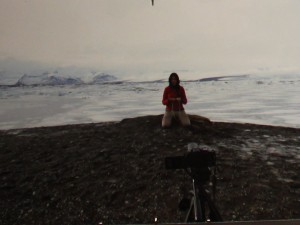 glaciers all around.
glaciers all around.
“The whole experience was just so overwhelming. So overpowering. The landscape, the sea, was so expansive and uninterrupted. There we were on top of the world, so elevated that everything else seemed so small and inconsequential. I felt such a deep sense of gratitude that it made me want to cry. Professor Roes told me to just go with the 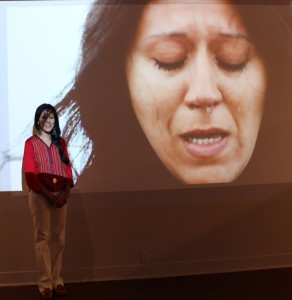 emotion. To release it. And instead of having the camera take in my entire body as I’d originally intended, she focused the lens on just my face.” Roes’ well-hewn instincts were spot on. The close up footage of a crying, runny-nosed Mesdaghi took command of the Bob Rauschenberg Gallery during a follow-up to Yoko One Imagine Peace called ferdalag (which translates a journey or voyage; a creative process of self-discovery and overcoming)..
emotion. To release it. And instead of having the camera take in my entire body as I’d originally intended, she focused the lens on just my face.” Roes’ well-hewn instincts were spot on. The close up footage of a crying, runny-nosed Mesdaghi took command of the Bob Rauschenberg Gallery during a follow-up to Yoko One Imagine Peace called ferdalag (which translates a journey or voyage; a creative process of self-discovery and overcoming)..
“The breakthrough for me was the creative power that comes from being in the moment,” Leila 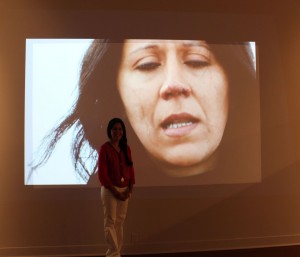 explained during the opening, unintentionally echoing the message of master entrepreneur, hip-hop mogul and New York Times bestselling author Russell Simmons, who advocates meditation as the fundamental key to living in the moment and releasing your untapped potential. As she worked her way around the length of her prayer beads, Leila never broke the immediacy of the performance, not even to wipe away a tear or the stream of mucous dripping over her lips in the
explained during the opening, unintentionally echoing the message of master entrepreneur, hip-hop mogul and New York Times bestselling author Russell Simmons, who advocates meditation as the fundamental key to living in the moment and releasing your untapped potential. As she worked her way around the length of her prayer beads, Leila never broke the immediacy of the performance, not even to wipe away a tear or the stream of mucous dripping over her lips in the 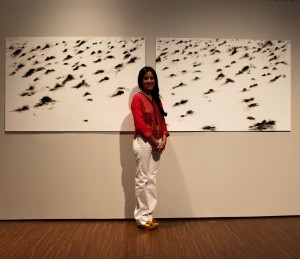 bitter Icelandic wind and cold.
bitter Icelandic wind and cold.
In 2013, Mesdaghi performed a piece she titled Unspoken Words on the limestone steps of the Sidney & Berne Davis Art Center in the downtown Fort Myers River District. “I believe that the root cause of violence and abuse is lack of selfless love,” says Leila of the Unspoken Words. “ To increase the level of love in our blood and in the air, I decided to read love poems by Rumi. I invited the 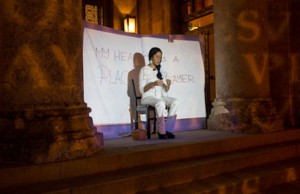 audience to choose a poem, write it, bring it to me , and in return, I read each poem one hundred times.”
audience to choose a poem, write it, bring it to me , and in return, I read each poem one hundred times.”
Mesdaghi hopes her work opens people’s eyes and helps change their attitudes about themselves, other countries and other people. “That’s what art is for. It goes beyond borders.” Of course, 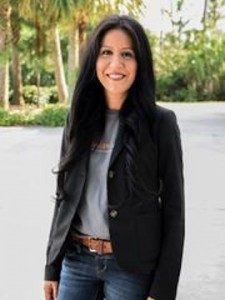 the themes she expounds through her performance and video pieces and paintings sometimes spark anti-foreigner sentiment. “They’ll say, ‘Well, if you don’t like it, why don’t you go back where you came from?’” But where Leila comes from is the United States. Although she was raised in Iran and educated there (she holds a Bachelors in Law from Tehran Azad University, Iran), she is American in birth right and temperament.
the themes she expounds through her performance and video pieces and paintings sometimes spark anti-foreigner sentiment. “They’ll say, ‘Well, if you don’t like it, why don’t you go back where you came from?’” But where Leila comes from is the United States. Although she was raised in Iran and educated there (she holds a Bachelors in Law from Tehran Azad University, Iran), she is American in birth right and temperament.
“Because I have an accent and because I have a diverse background, [they believe that] I don’t have the right to speak up,” Mesdaghi told the Fort Myers News-Press in a 2015 interview. But speak up she does. For example, Leila went out of her way 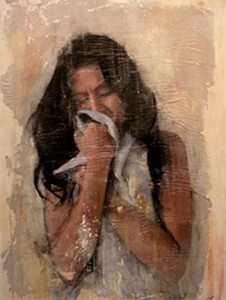 to attend a recent meeting of the City of Fort Myers Public Art Committee that had been convened to decide whether a statue named Territorio (by internationally known Colombian artist Edguardo Carmona) should be removed from the corner of Main and Hendry Streets in the downtown Fort Myers River District because it depicts a man and his dog urinating on a lamppost. “I don’t want to worry that I’m living in a small pond and that I need to leave here to be able to be a practicing artist,” Leila to the Committee. “Same as other little children when they pass by, when they look at something they want to be inspired that they can be creative and they should not censor themselves.”
to attend a recent meeting of the City of Fort Myers Public Art Committee that had been convened to decide whether a statue named Territorio (by internationally known Colombian artist Edguardo Carmona) should be removed from the corner of Main and Hendry Streets in the downtown Fort Myers River District because it depicts a man and his dog urinating on a lamppost. “I don’t want to worry that I’m living in a small pond and that I need to leave here to be able to be a practicing artist,” Leila to the Committee. “Same as other little children when they pass by, when they look at something they want to be inspired that they can be creative and they should not censor themselves.”
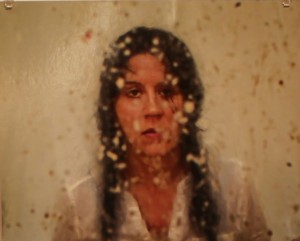 In addition to her performance pieces, Leila explores many other disciplines and media, from traditional painting to sculpture, printmaking, installations, and video art. But through them all, she continually seeks to prompt thought, introspection and discourse.
In addition to her performance pieces, Leila explores many other disciplines and media, from traditional painting to sculpture, printmaking, installations, and video art. But through them all, she continually seeks to prompt thought, introspection and discourse.
Mesdaghi holds a Bachelor of Arts from Florida Gulf Coast University and a B.A. in Law from Tehran Azad University, Tehran, Iran.
More about Performance Art
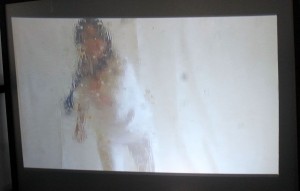 Performance is a genre of art that is typically presented live by the artist, either alone or in conjunction with performers, collaborators and sometimes even random viewers or spectators. It traces its origins back to Futurism and Dadaism and is characteristically employed to express discontent with conventional forms of art, such as
Performance is a genre of art that is typically presented live by the artist, either alone or in conjunction with performers, collaborators and sometimes even random viewers or spectators. It traces its origins back to Futurism and Dadaism and is characteristically employed to express discontent with conventional forms of art, such as 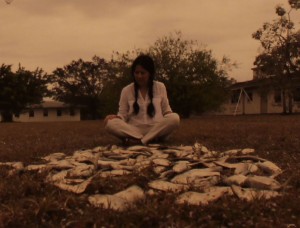 painting and traditional modes of sculpture. But it can also be used to give voice to deeper psycho-social and political issues. Not surprisingly, a significant number of performance art pieces were conceived and presented in the 1960s, where they explored topics that ranged from the rise of feminism to anti-war activism.
painting and traditional modes of sculpture. But it can also be used to give voice to deeper psycho-social and political issues. Not surprisingly, a significant number of performance art pieces were conceived and presented in the 1960s, where they explored topics that ranged from the rise of feminism to anti-war activism.
Although the concerns of performance artists 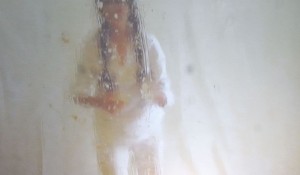 have changed since the 1960s, the genre has remained a constant presence and has largely been welcomed into the conventional museums and galleries from which it was once excluded. In many instances, performance artists have deliberately included shocking components in an attempt to engage viewers both intellectually and
have changed since the 1960s, the genre has remained a constant presence and has largely been welcomed into the conventional museums and galleries from which it was once excluded. In many instances, performance artists have deliberately included shocking components in an attempt to engage viewers both intellectually and 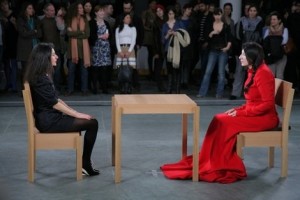 emotionally in their work. In one recent exhibit at New York’s Museum of Modern Art, for example, one interactive performance piece left viewers tearful, shaken and inspired enough to permanently memorialize the experience through tattoos. Titled The Artist is Present, the exhibit featured artist Marina Abramovic seated in a chair staring
emotionally in their work. In one recent exhibit at New York’s Museum of Modern Art, for example, one interactive performance piece left viewers tearful, shaken and inspired enough to permanently memorialize the experience through tattoos. Titled The Artist is Present, the exhibit featured artist Marina Abramovic seated in a chair staring 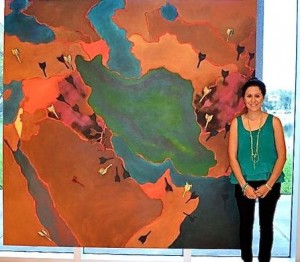 intently across a small table at an empty chair. Members of the audience took turns occupying that chair as Abramovic peered through their eyes and seemingly into their very souls. Some laughed self-consciously. Many broke down in tears. Virtually all experienced some type of dramatic, raw emotion.
intently across a small table at an empty chair. Members of the audience took turns occupying that chair as Abramovic peered through their eyes and seemingly into their very souls. Some laughed self-consciously. Many broke down in tears. Virtually all experienced some type of dramatic, raw emotion.
___________________________________________________
RECENT DEVELOPMENTS.
Mesdaghi solo show ‘Love Cannot Alter It’ at Cape Coral Art Center through 1-23-20
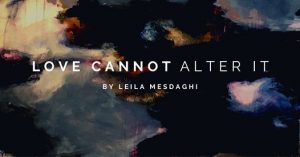 The Cape Coral Art Center is featuring Leila Mesdaghi in a solo exhibition that opens on Friday, January 11. This exhibition is an invitation to look into things we cannot change, words we cannot take back, and feelings that hold us back.
The Cape Coral Art Center is featuring Leila Mesdaghi in a solo exhibition that opens on Friday, January 11. This exhibition is an invitation to look into things we cannot change, words we cannot take back, and feelings that hold us back.
For Mesdaghi, making art is a combination of emotional experiences 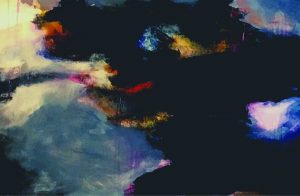 and social responsibilities. Leila seeks to connect with her viewers in a visceral, evocative, and emotional manner. Intentionally occupying uncomfortable ground, the Iranian-Columbian artist challenges how we observe, react and respond – easing us into conversations that take us to vulnerable places that afford new insights and understanding.
and social responsibilities. Leila seeks to connect with her viewers in a visceral, evocative, and emotional manner. Intentionally occupying uncomfortable ground, the Iranian-Columbian artist challenges how we observe, react and respond – easing us into conversations that take us to vulnerable places that afford new insights and understanding.
 In Love Cannot Alter It, a title inspired by a sentence from Anne Carson’s book Nox, Leila thinks about the “emotionscapes” of fear of abandonment – physically and psychologically. To her, sometimes the only choice we have is to sit with our pain, embrace ourselves, and experience aloneness. Facing what we fear and maneuvering through the narrow paths of not knowing leads us to deeper places that will become familiar.
In Love Cannot Alter It, a title inspired by a sentence from Anne Carson’s book Nox, Leila thinks about the “emotionscapes” of fear of abandonment – physically and psychologically. To her, sometimes the only choice we have is to sit with our pain, embrace ourselves, and experience aloneness. Facing what we fear and maneuvering through the narrow paths of not knowing leads us to deeper places that will become familiar.
The exhibit will be 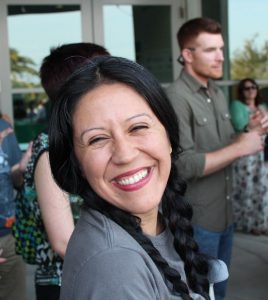 on display through January 23. A reception to view the exhibit and meet the artist will be held from 5:00-7:00 p.m. on January.
on display through January 23. A reception to view the exhibit and meet the artist will be held from 5:00-7:00 p.m. on January.
The Cape Coral Art Center will also feature the Vision 2020 exhibit to celebrate Cape Coral’s 50th anniversary as an incorporated city. Vision 2020 depicts this history through visual representation.
The art center is located at 4533 Coronado Parkway. For more information about the art center and its programs, call 239-574-0802 or visit www.capeparks.net.
_____________________________________________________________________
Leila Mesdaghi obsesses over childhood story in FGCU’s ’20/20: Art Alumni Exhibition (08-26-17)
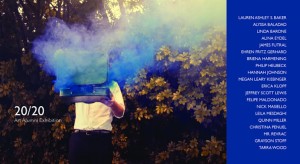 On view now through September 21 at Florida Gulf Coast University is 20/20: Art Alumni Exhibition. As the name connotes, twenty alumni of the FGCU art program are exhibiting their work in celebration of the university’s twentieth anniversary. Among the twenty is artist Leila Mesdaghi, a member of the class of 2016.
On view now through September 21 at Florida Gulf Coast University is 20/20: Art Alumni Exhibition. As the name connotes, twenty alumni of the FGCU art program are exhibiting their work in celebration of the university’s twentieth anniversary. Among the twenty is artist Leila Mesdaghi, a member of the class of 2016.
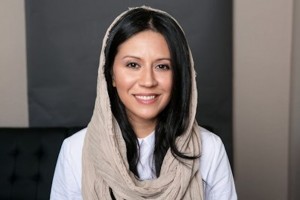 In her work, Mesdaghi often investigates her self-imposed illusions, emotions, relationships and memories. In fact, she prefers the term obsess. “My process becomes about finding tangible ways to relate to them,” Leila acknowledges. And in her “Barzakh Series,” she obsesses about one childhood memory in particular.
In her work, Mesdaghi often investigates her self-imposed illusions, emotions, relationships and memories. In fact, she prefers the term obsess. “My process becomes about finding tangible ways to relate to them,” Leila acknowledges. And in her “Barzakh Series,” she obsesses about one childhood memory in particular.
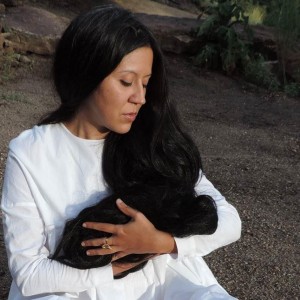 When she was a little girl, she heard in a story about a man who “saw a woman hanging by her hair.” The image made her more curious than afraid. “To this day, I keep questioning that memory,” states the artist. “What an extreme punishment! How would that even be possible? What would it feel like? How long would one last before the scalp tears off the skull and where would one fall?”
When she was a little girl, she heard in a story about a man who “saw a woman hanging by her hair.” The image made her more curious than afraid. “To this day, I keep questioning that memory,” states the artist. “What an extreme punishment! How would that even be possible? What would it feel like? How long would one last before the scalp tears off the skull and where would one fall?”
While the latter musing may seem gruesome to some, Mesdaghi has built a reputation for provocative visual installations and  performance art pieces that comment on psycho-social and political issues. For example, in the video performance piece she put together for her FGCU senior project, Privilege of Removal, she threw dead fish against a pane of glass to metaphorically challenge the ways in which we observe, react and respond to social and political issues. “We watch real life behaviors of physical, verbal, and moral abuse on T.V. and computer
performance art pieces that comment on psycho-social and political issues. For example, in the video performance piece she put together for her FGCU senior project, Privilege of Removal, she threw dead fish against a pane of glass to metaphorically challenge the ways in which we observe, react and respond to social and political issues. “We watch real life behaviors of physical, verbal, and moral abuse on T.V. and computer 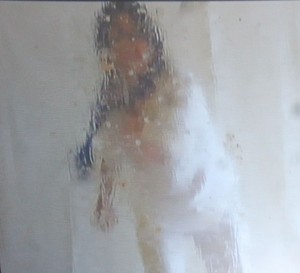 screens, and instead of rejecting, we justify and accept them as socio-political norms,” Leila noted at the time. “By literally throwing dead fish at a pane of glass, I act as a violent exhibitionist and also remind the viewer of our silent voyeuristic nature. I smash dead fish against the barrier that separates the world we live in from the world we witness.”
screens, and instead of rejecting, we justify and accept them as socio-political norms,” Leila noted at the time. “By literally throwing dead fish at a pane of glass, I act as a violent exhibitionist and also remind the viewer of our silent voyeuristic nature. I smash dead fish against the barrier that separates the world we live in from the world we witness.”
Mesdaghi has never been one to shy away from childhood memories, even those that may be somewhat unpleasant. When 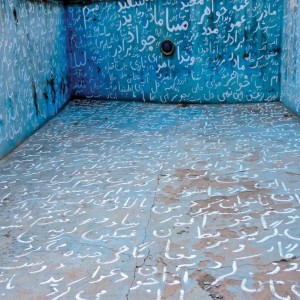 she visited her father in Tehran recently, she discovered that the pool in his garden has been empty for forty years. So she used the chalky concrete walls as a canvas on which to inscribe her childhood memories. For Quest for Permanence, she reconstituted the pool and her inscriptions in the Wasmer Art Gallery to not only make a powerful statement about the fragility of memory, but the ways in which we alter long-term memories each time we retrieve and review them.
she visited her father in Tehran recently, she discovered that the pool in his garden has been empty for forty years. So she used the chalky concrete walls as a canvas on which to inscribe her childhood memories. For Quest for Permanence, she reconstituted the pool and her inscriptions in the Wasmer Art Gallery to not only make a powerful statement about the fragility of memory, but the ways in which we alter long-term memories each time we retrieve and review them.
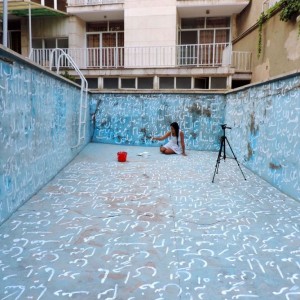 “I used the pool as a personal piece to reflect the memories that we all have and can relate to,” she noted during her gallery talk at the opening of the exhibition. “Who died, who got married, who beat up someone. Like most families, not all the memories there are sweet.”
“I used the pool as a personal piece to reflect the memories that we all have and can relate to,” she noted during her gallery talk at the opening of the exhibition. “Who died, who got married, who beat up someone. Like most families, not all the memories there are sweet.”
Mesdaghi welcomes emotions related to guilt, love, regret and despair. She knows deep down that they are not only personal, but universal as well. “My body becomes my medium, a body continually waiting, repeating and enduring,” she tells. “I make 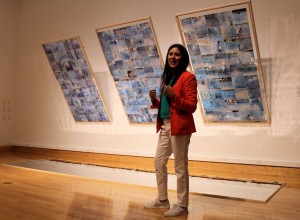 art to take control, to find refuge, and to see comfort.” The only suspense is the form these emotions will take in any given visual installation or performance art piece.
art to take control, to find refuge, and to see comfort.” The only suspense is the form these emotions will take in any given visual installation or performance art piece.
And in “Barzakh,” the suspense is endless.
Leila Mesdaghi lives and works in Fort Myers. In 2016, she was represented at the 2nd Contemporary Art Biennale Peace on Paper in Tehran, Iran, at the 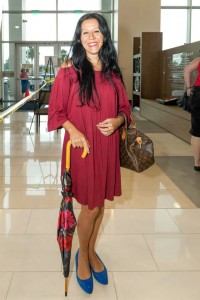 Abadan Contemporary Art Museum and the Isfahan Contemporary Arts Museum. For more on Mesdaghi and her art, please visit here.
Abadan Contemporary Art Museum and the Isfahan Contemporary Arts Museum. For more on Mesdaghi and her art, please visit here.
The opening reception and 20th Anniversary Art Walk will take place in connection with the exhibition from 5:00 to 8:00 p.m. on Thursday, August 31. The Wasmer Art Gallery is in the Arts Complex. The ArtLab Gallery is at the west side of the Library building on FGCU’s main campus at 10501 FGCU Boulevard South. Parking is available in Lot 7 for gallery visitors. Regular viewing hours are 10 a.m. to 4 p.m. Monday through Friday, and 10 a.m. to 7 p.m. Thursday.
_______________________________________________________________________
‘Symbiotic: Malerba/Mesdaghi’ coming to Davis Art Center in August via Colorado Springs (07-18-16)
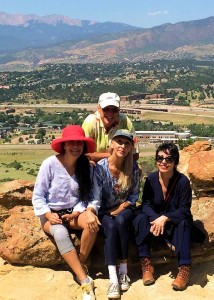 Avant garde fashion designer Mariapia Malerba and performance artist Leile Mesdaghi have achieved another milestone in their respective careers. Both have become the first Southwest Florida artists to be invited by Sun Peaks Center for Art & Sustainability in Colorado Springs, Colorado to participate in its tw0-week artist residency program. The works they create will be presented during August Art Walk at the Sidney & Berne Davis Art Center (SBDAC).
Avant garde fashion designer Mariapia Malerba and performance artist Leile Mesdaghi have achieved another milestone in their respective careers. Both have become the first Southwest Florida artists to be invited by Sun Peaks Center for Art & Sustainability in Colorado Springs, Colorado to participate in its tw0-week artist residency program. The works they create will be presented during August Art Walk at the Sidney & Berne Davis Art Center (SBDAC).
Sun Peaks Center for Art & Sustainability is a non-profit educational organization that explores new designs and ideas which embody a new balance between current technology and future possibilities, bringing breakthroughs in environmental science down to a 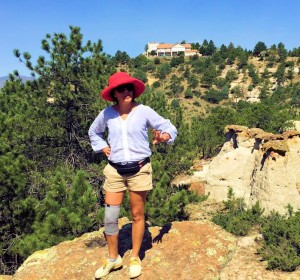 comfortable, understandable human scale. It is a collaboration between Ray Armstrong, the developer of the property, and Marne Adler, an internationally known artist and arts educator and advocate, in which their unique vision of combining science and art to inspire a model of sustainability in the areas of water conservation, renewable energy, gardens, Koi ponds and art and design has come to life.
comfortable, understandable human scale. It is a collaboration between Ray Armstrong, the developer of the property, and Marne Adler, an internationally known artist and arts educator and advocate, in which their unique vision of combining science and art to inspire a model of sustainability in the areas of water conservation, renewable energy, gardens, Koi ponds and art and design has come to life.
Malerba and Mesdaghi will return home at the end 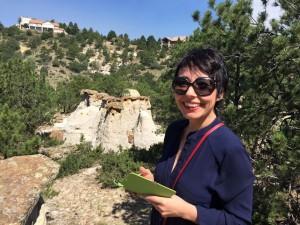 of the month to present the work they created in their own exhibit opening August 5 at the Sidney & Berne Davis Art Center in downtown Fort Myers. Titled Symbiotic: Malerba/Mesdaghi, the show will represent their reflection and meditation on their creative processes in a setting that preserves the integrity of earth’s natural resources.
of the month to present the work they created in their own exhibit opening August 5 at the Sidney & Berne Davis Art Center in downtown Fort Myers. Titled Symbiotic: Malerba/Mesdaghi, the show will represent their reflection and meditation on their creative processes in a setting that preserves the integrity of earth’s natural resources.
Mariapia Malerba is an Italian-American artist 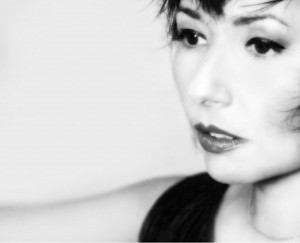 who was born in Puglia, a region in Southern Italy. She studied art in high school and then went on to study at Accademia di Belle Arti, a fine art institute in Florence, Italy. After earning a degree in art, with primary coursework in scenography, set design, and costume history, Malerba moved to Lake Como in Lombardy, Italy to work as a textile designer. She has created textile designs for well-known fashion designers, such as Dolce and
who was born in Puglia, a region in Southern Italy. She studied art in high school and then went on to study at Accademia di Belle Arti, a fine art institute in Florence, Italy. After earning a degree in art, with primary coursework in scenography, set design, and costume history, Malerba moved to Lake Como in Lombardy, Italy to work as a textile designer. She has created textile designs for well-known fashion designers, such as Dolce and 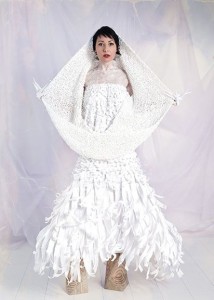 Gabana, Versace, and Roberto Cavalli. Working in Italy was an extraordinary time for Malerba to grow as an artist.
Gabana, Versace, and Roberto Cavalli. Working in Italy was an extraordinary time for Malerba to grow as an artist.
Malerba was born with a strong penchant to examine the beauty of life. Every morning, she wakes with enthusiasm to bring her ideas and her art to life. Colors, objects, and shapes fascinate her. She enjoys combining concepts that are diverse. With work ranging from abstraction to hyperrealism, Malerba’s art has been showcased in various galleries all over Italy and America, winning the “Raffaello Sanzio” first-place award in Rome in 2006.
Malerba was featured as a signature designer during the opening  night of SBDAC’s Art Walks the Runway Fashion Show this year. For more information on Mariapia Malerba visit Maria-pia-art.com.
night of SBDAC’s Art Walks the Runway Fashion Show this year. For more information on Mariapia Malerba visit Maria-pia-art.com.
Leila Mesdaghi is an Iranian-American Artist living in Fort Myers, Florida. She holds a B,A, in Law from Tehran Azad University, Iran, and a B.A. in Arts from Florida Gulf Coast University. Her art is a merger of emotional experiences and social responsibilities in which she seeks to connect with viewers in a visceral, evocative, emotional manner. She often stands on uncomfortable ground and challenges how we observe, react, and respond to social and political issues like war in the Middle East, the negative reflections  of social media in society, the housing crisis in the U.S, and the price and promise of progress. In addition to years of traditional painting, Mesdaghi has explored disciplines and mediums such as sculpture, printmaking, and installation. In her most recent works, she has been merging performance with video and photography, exploring the spaces between presence and absence.
of social media in society, the housing crisis in the U.S, and the price and promise of progress. In addition to years of traditional painting, Mesdaghi has explored disciplines and mediums such as sculpture, printmaking, and installation. In her most recent works, she has been merging performance with video and photography, exploring the spaces between presence and absence.
Leila is SBDAC’s 2016 “Best in Show” winner from the June Juried Exhibition, in which she presented a performance piece titled Deeper Than Sorrow II. For more information on Mesdaghi, please visit leilamesdaghi.com.
 Later this summer fellow Southwest Florida artists Renee Rey, Kelly Wise, and Leila Younes will join Sun Peaks in the next artist-in-residency session. For more information on the Sun Peaks Residency program, visit sunpeaksartandsustainability.org.
Later this summer fellow Southwest Florida artists Renee Rey, Kelly Wise, and Leila Younes will join Sun Peaks in the next artist-in-residency session. For more information on the Sun Peaks Residency program, visit sunpeaksartandsustainability.org.
Symbiotic: Malerba/Mesdaghi will open during Art Walk August 5. Art Walk operates every first Friday of the month from 6:00 to 10:00 p.m. The August exhibit will run from August 5 to  August 23. Gallery hours are from 9:30 a.m. to 4:30 p.m. Please call 239-333-1933 or visit www.sbdac.com for more information. The gallery is located in the historic United States Post Office Building that was completed and dedicated in 1933. The Sidney & Berne Davis Art Center is located at 2301 First Street in the downtown Fort Myers River District.
August 23. Gallery hours are from 9:30 a.m. to 4:30 p.m. Please call 239-333-1933 or visit www.sbdac.com for more information. The gallery is located in the historic United States Post Office Building that was completed and dedicated in 1933. The Sidney & Berne Davis Art Center is located at 2301 First Street in the downtown Fort Myers River District.
__________________________________________________________________
Leila Mesdaghi wins Overall Best of Show at Davis Art Center for ‘Deeper Than Sorrow II (06-11-16)
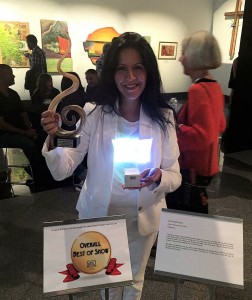 Every year, the Sidney & Berne Davis Art Center holds a themed juried art exhibition. This year’s them was Notes – monetary, musical, handwritten or otherwise. Not surprisingly, the theme spurred some beautiful art with powerful emotional content. And the most powerful of these was Leila Mesdaghi’s Deeper Than Sorrow II, which won Overall Best of Show.
Every year, the Sidney & Berne Davis Art Center holds a themed juried art exhibition. This year’s them was Notes – monetary, musical, handwritten or otherwise. Not surprisingly, the theme spurred some beautiful art with powerful emotional content. And the most powerful of these was Leila Mesdaghi’s Deeper Than Sorrow II, which won Overall Best of Show.
Dedicated an uncle who passed away in 2001, Deeper Than Sorrow II is a performance piece that depicts the artist sitting at the bottom of an empty swimming pool writing a poem on the stretch of faded concrete wall. The poem is the 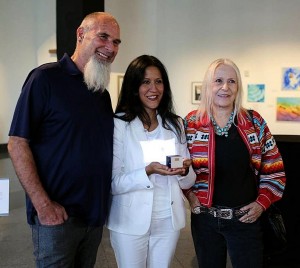 one engraved on her uncle’s grave, and it is about the pain of separation and longing.
one engraved on her uncle’s grave, and it is about the pain of separation and longing.
“I entered my family’s old pool that has been sitting in our garden in Tehran, Iran for the past forty years,” Leila notes. “There used to be ten of us living there. Year after year, one after another, we all moved away to different places. By writing on the cracked and faded walls of the pool, I began a dialog between memory and perception, alluding to a universal longing.”
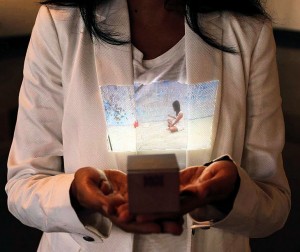 As the piece’s title suggests, it is the outgrowth of another, larger installation that debuted at Florida Gulf Coast University in Quest for Permanence, an exhibit of work on view through June 23 that examines the tensions that arise as time and place collide. You can read more about Deeper Than Sorrow I in the following article.
As the piece’s title suggests, it is the outgrowth of another, larger installation that debuted at Florida Gulf Coast University in Quest for Permanence, an exhibit of work on view through June 23 that examines the tensions that arise as time and place collide. You can read more about Deeper Than Sorrow I in the following article.
One thing’s for sure. With a Best of Show in the Notes, Leila Mesdaghi is an artist on the rise, and there’s no ceiling, glass or otherwise, to limit how high she can rise.
Congratulations Leila!
________________________________________________________
With ‘Deeper Than Sorrow,’ FGCU art grad Leila Mesdaghi explores impermanence of memory (05-21-16)
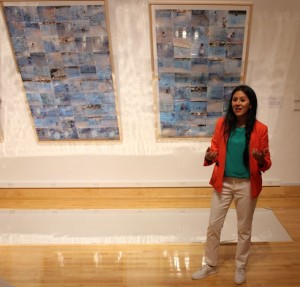 When Gallery Director John Loscuito invited Leila Mesdaghi to join the exhibitors in Quest for Permanence, she was flattered. After all, the ink on her art degree from FGCU was barely dry. But then she got to thinking about the theme of the exhibition. Quest for Permanence. Quest for permanence.
When Gallery Director John Loscuito invited Leila Mesdaghi to join the exhibitors in Quest for Permanence, she was flattered. After all, the ink on her art degree from FGCU was barely dry. But then she got to thinking about the theme of the exhibition. Quest for Permanence. Quest for permanence.
“I did [Deeper Than Sorrow] specifically for this show in a pool in my father’s garden in Tehran that has been sitting empty for the past forty years,” Leila  told the crowd that assembled for the opening of the exhibit on May 17. “My father’s home is still there, one of the few original homes left in the neighborhood.” In fact, she noted that her plans to inscribe the memories of her childhood on the walls of the empty pool were altered by the demolition of the house next door. “During the day, there was all this debris flying around,” she
told the crowd that assembled for the opening of the exhibit on May 17. “My father’s home is still there, one of the few original homes left in the neighborhood.” In fact, she noted that her plans to inscribe the memories of her childhood on the walls of the empty pool were altered by the demolition of the house next door. “During the day, there was all this debris flying around,” she 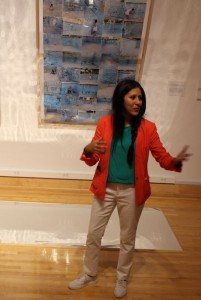 related. “So I could only go into the pool early in the morning and late in the afternoon.”
related. “So I could only go into the pool early in the morning and late in the afternoon.”
Her concept was straightforward. “The pool has been the witness to our lives there,” Leila remarked as she stood in front of a simulated pool on the floor of the FGCU art gallery. “There were ten of us living there. My mom, my dad, my aunt and my uncle, and we moved away from there one after the other until only my dad and my uncle are still living in that house.”
While Quest for Permanence is the theme of the exhibition, everyone acknowledges that memory is temporal, at best. It fades and become 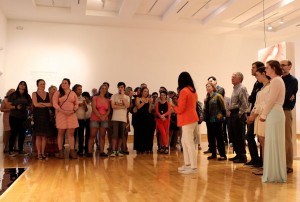 murky with the passage of time. In later life, it can be lost entirely to the ravages of advancing age or diseases such as dementia or Alzheimer’s Syndrome. “Most people know there are two kinds of memory, short-term and long-term. What you may not know is that each time you pull up a long-term memory and review it, you alter it. In time, that memory can become false entirely, or
murky with the passage of time. In later life, it can be lost entirely to the ravages of advancing age or diseases such as dementia or Alzheimer’s Syndrome. “Most people know there are two kinds of memory, short-term and long-term. What you may not know is that each time you pull up a long-term memory and review it, you alter it. In time, that memory can become false entirely, or 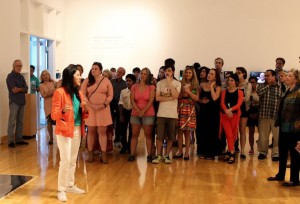 falsity papered over reality,” writes author Cedar Sanderson in “The Impermanence of Memory.”
falsity papered over reality,” writes author Cedar Sanderson in “The Impermanence of Memory.”
Even though Leila and most of her family are physically absent from the home, there remains evidence of them throughout the structure. “Our stuff, such as old books we once read, is still all around the house.” And that stuff in combination 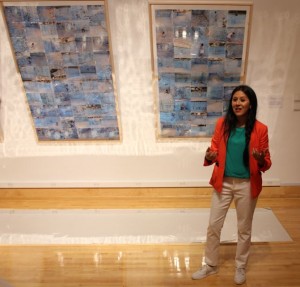 with her father’s and uncle’s recollections helped Leila piece together memories of the past. Some fresh. Others long forgotten.
with her father’s and uncle’s recollections helped Leila piece together memories of the past. Some fresh. Others long forgotten.
But in addition to the fragility of memory, Mesdaghi also discovered that what we recall is tempered by our perceptions both at the time an even occurred as well as at the time the event is recalled. That’s why eyewitness testimony is regarded by police detectives and lawyers as inherently unreliable.
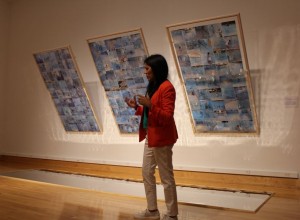 Still, Leila was inspired to recover, recreate and give voice to the events which her father’s pool witnessed over four decades as the family interacted with each other and the outside world as they lived their daily lives. “The house is the physical location of all these secrets,” Leila added wistfully during the exhibition’s opening Gallery Talk. “I used the pool as a personal piece to reflect
Still, Leila was inspired to recover, recreate and give voice to the events which her father’s pool witnessed over four decades as the family interacted with each other and the outside world as they lived their daily lives. “The house is the physical location of all these secrets,” Leila added wistfully during the exhibition’s opening Gallery Talk. “I used the pool as a personal piece to reflect 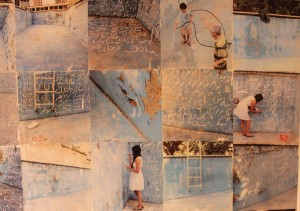 the memories that we all have and can relate to. Who died, who got married, who beat up someone. Like most families, not all the memories there are sweet.”
the memories that we all have and can relate to. Who died, who got married, who beat up someone. Like most families, not all the memories there are sweet.”
And so with the help of her son and her father, Mesdaghi cleaned the cracked and faded walls of the empty pool and then began inscribing into the concrete the happenings she recalled. “Her 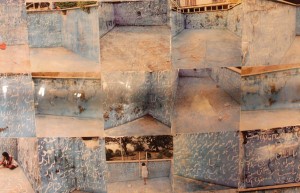 marks behave as an instrument to recuperate from the pain of separation, opening a dialogue between memory and perception, alluding to a universal longing,” states the syllabus to Deeper Than Sorrow.
marks behave as an instrument to recuperate from the pain of separation, opening a dialogue between memory and perception, alluding to a universal longing,” states the syllabus to Deeper Than Sorrow.
Mesdaghi recorded each mark-making session and combined 150 stills on three laminated panels 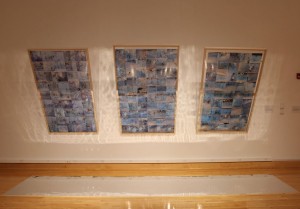 hung at a downward angle facing the reflection pool on the gallery floor. Taken together, the stills merge and blend together metaphorically in much the same way that events are often mixed together and intertwined in our minds, forcing us to struggle to resurrect individual occurrences and recall them with some semblance of clarity and accuracy.
hung at a downward angle facing the reflection pool on the gallery floor. Taken together, the stills merge and blend together metaphorically in much the same way that events are often mixed together and intertwined in our minds, forcing us to struggle to resurrect individual occurrences and recall them with some semblance of clarity and accuracy.
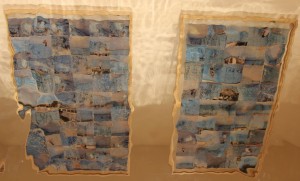 But look at those same images through the medium of the reflection pool! Not only are they reversed, they are distorted as well in a way that draws parallels to Dali’s Persistence of Memory.
But look at those same images through the medium of the reflection pool! Not only are they reversed, they are distorted as well in a way that draws parallels to Dali’s Persistence of Memory.
“The marks she leaves behind will fade as time goes by,” the plaque on the wall of the Art Gallery at FGCU concedes, “but the memory of her 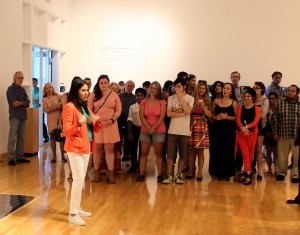 presence will always remain.” Perhaps, but will the memory of the family’s presence be accessible to them or to others … and for how long?
presence will always remain.” Perhaps, but will the memory of the family’s presence be accessible to them or to others … and for how long?
Quest for Permanence.
Maybe it’s enough for memory to last as long as there remains someone, anyone, with an interest in recalling it. For memory to endure beyond that, we must enter the exalted realm of legacy, which 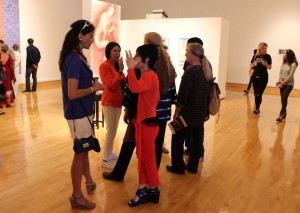 is, after all, a more revered and sacrosanct quest for permanence.
is, after all, a more revered and sacrosanct quest for permanence.
Be that as it may, Leile Mesdaghi continues to create thought-provoking and challenging visual and interactive art pieces. And with a shiny new degree from FGCU, she’s only getting started.
You go girl!













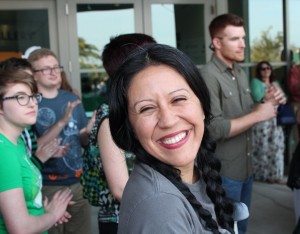

 Tom Hall is both an amateur artist and aspiring novelist who writes art quest thrillers. He is in the final stages of completing his debut novel titled "Art Detective," a story that fictionalizes the discovery of the fabled billion-dollar Impressionist collection of Parisian art dealer Josse Bernheim-Jeune, thought by many to have perished during World War II when the collection's hiding place, Castle de Rastignac in southern France, was destroyed by the Wehrmacht in reprisal for attacks made by members of the Resistance operating in the area. A former tax attorney, Tom holds a bachelor's degree as well as both a juris doctorate and masters of laws in taxation from the University of Florida. Tom lives in Estero, Florida with his fiancee, Connie, and their four cats.
Tom Hall is both an amateur artist and aspiring novelist who writes art quest thrillers. He is in the final stages of completing his debut novel titled "Art Detective," a story that fictionalizes the discovery of the fabled billion-dollar Impressionist collection of Parisian art dealer Josse Bernheim-Jeune, thought by many to have perished during World War II when the collection's hiding place, Castle de Rastignac in southern France, was destroyed by the Wehrmacht in reprisal for attacks made by members of the Resistance operating in the area. A former tax attorney, Tom holds a bachelor's degree as well as both a juris doctorate and masters of laws in taxation from the University of Florida. Tom lives in Estero, Florida with his fiancee, Connie, and their four cats.